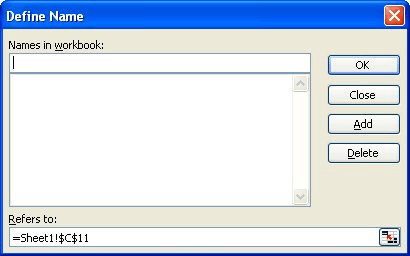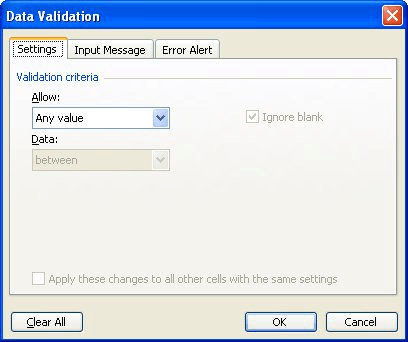Please Note: This article is written for users of the following Microsoft Excel versions: 97, 2000, 2002, and 2003. If you are using a later version (Excel 2007 or later), this tip may not work for you. For a version of this tip written specifically for later versions of Excel, click here: Contingent Validation Lists.
Written by Allen Wyatt (last updated August 15, 2022)
This tip applies to Excel 97, 2000, 2002, and 2003
The data validation capabilities in Excel are quite handy, particularly if your worksheets will be used by others. When developing a worksheet, you might wonder if there is a way to make the choices in one cell contingent on what is selected in a different cell. For instance, you may set up the worksheet so that cell A1 uses data validation to select a product from a list of products. You would then like the validation rule in cell B1 to present different validation lists based on the product selected in A1.
The easiest way to accomplish this task is in this manner:

Figure 1. The Define Name dialog box.

Figure 2. The Data Validation dialog box.
That's it. Now, whatever is chosen in cell A1 dictates which list is presented in cell B1.
ExcelTips is your source for cost-effective Microsoft Excel training. This tip (3195) applies to Microsoft Excel 97, 2000, 2002, and 2003. You can find a version of this tip for the ribbon interface of Excel (Excel 2007 and later) here: Contingent Validation Lists.

Dive Deep into Macros! Make Excel do things you thought were impossible, discover techniques you won't find anywhere else, and create powerful automated reports. Bill Jelen and Tracy Syrstad help you instantly visualize information to make it actionable. You’ll find step-by-step instructions, real-world case studies, and 50 workbooks packed with examples and solutions. Check out Microsoft Excel 2019 VBA and Macros today!
Need to enter the current time into a cell? It's easy to do using this keyboard shortcut. The shortcut is a handy one to ...
Discover MoreExcel includes several different methods of editing information in your cells. If you want to edit multiple cells all at ...
Discover MoreWhen editing a cell, you may want to cancel the edit at some point. There are two ways to do this, both described in this ...
Discover MoreFREE SERVICE: Get tips like this every week in ExcelTips, a free productivity newsletter. Enter your address and click "Subscribe."
There are currently no comments for this tip. (Be the first to leave your comment—just use the simple form above!)
Got a version of Excel that uses the menu interface (Excel 97, Excel 2000, Excel 2002, or Excel 2003)? This site is for you! If you use a later version of Excel, visit our ExcelTips site focusing on the ribbon interface.
FREE SERVICE: Get tips like this every week in ExcelTips, a free productivity newsletter. Enter your address and click "Subscribe."
Copyright © 2026 Sharon Parq Associates, Inc.
Comments